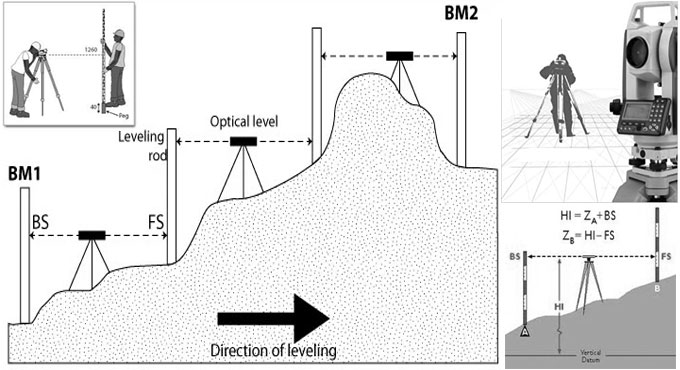
Types of Leveling Methods in Surveying
Leveling is the most generally utilized technique for getting the elevations of ground points comparative with a reference datum and is normally done as a different system to those utilized in fixing planimetric position. The fundamental idea of leveling includes the estimation of vertical separation comparative with a horizontal line of sight. Consequently, it requires a graduated staff for the vertical estimations and an instrument that gives a horizontal line of sight.
The different types of Leveling in ground survey are:
a. Precise or Geodetic Leveling
b. Ordinary or Simple Leveling
Techniques for Leveling
Techniques for leveling might be immediate, for example:
1. Simple Leveling
2. Differential Leveling
3. Profile Leveling
4. Cross Sectioning
5. Reciprocal Leveling
6. Precise leveling
7. Check Leveling
8. Fly Leveling
Or then again might be aberrant, e.g.
1. Trigonometric Leveling
2. Barometric Leveling
3. Hypsometry
Leveling methodology
Setting up: Backsight and foresight separations ought to be around equivalent to dodge any errors because of collimation, refraction or earth arch. Separations must not be so incredible as to not have the option to peruse the graduations precisely. The points to be watched must be beneath the level of the instrument, yet not lower than the tallness of the staff.
Elimination of parallax: Parallax is the obvious development of the picture created by development of the spectator's eye at the eyepiece. It is disposed of by concentrating the telescope on unendingness and afterward modifying the eyepiece until the cross-hairs show up in sharp core interest. The setting will stay steady for a specific spectator's eye.
Booking: Level books or free leaf leveling sheets will be numbered and filed in a register. Subtleties of the site, work, date, onlooker, chainman, booker, climate, wind, instrument and some other pertinent things will be entered.
Enter the main perception (which is on a known point) in the Backsight section, and adequate detail in the Remarks segment to distinguish it. Enter the point's R.L. zero from the site register or plate on the BM, and so on.
Enter every single other point on resulting lines as intermediates aside from the point picked as the foresight. Recognize them in the Remarks section as above. Enter the foresight on a further line in the Foresight section.
Change the instrument to the following arrangement. Enter the accompanying backsight on a similar line as the past foresight yet in the Backsight segment. Rehash the above technique at every arrangement on the outward run at that point turn around it to work back to the beginning stage on the arrival run. The uttermost point out is treated with respect to all other change points.
Types of Levels: Instruments utilized for Leveling
Builder's or Engineer's Level: As inferred by the name, these are utilized by developers and specialists. Their structure is fundamentally as portrayed before, and they utilize graduated staffs in which the littlest graduation is 1cm. Millimeters must be assessed, and the precision of a solitary perusing will be around 2-3mm.
Computerized Level: This kind of level uses an uncommon bar-coded staff. The picture of the staff goes through the target focal point and afterward by means of a bar splitter to a photograph indicator exhibit, where it is digitized.
The microchip thinks about this picture to a duplicate of the bar code and figures the staff perusing, which is shown or potentially put away. The affectability of the gadget is with the end goal that solitary perusing exactness of 0.2mm to 0.3mm can be accomplished, and sight lengths can be reached out up to 100m.
Precise Level: This is a change of the regular level where an equal plate micrometer is set before the goal focal point. This permits the picture of the staff graduation to be gone up or somewhere near little quantifiable sums. For sight lengths of under 50m, single perusing exactnesses of 0.02mm to 0.03mm can be accomplished.
Errors in Leveling: These are the mistakes which often happen at the time of levelling in engineering survey. Common types of leveling errors include:
a. Collimation Error
b. Error because of Curvature and Refraction
c. Instrumental Errors
These errors may be further divided as instrumental errors, natural errors, error due to the earth?s curvature and human errors in Levelling field. Error can be reduced by proper adjustment and establishing standard field procedures and adhering to these but they cannot be eliminated.


